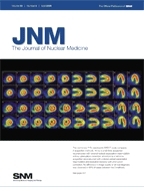by
Barbara Kram, Editor | April 01, 2009

The Journal of
Nuclear Medicine
Reston, VA -- In a study comparing the ability of various medical techniques to accurately determine the extent of heart disease and stratify patients according to disease severity, researchers found that myocardial perfusion testing with gated single photon emission computed tomography (gated SPECT) was a more accurate predictor of prognosis in chronic ischemic heart disease (IHD)-a painful condition caused by a temporary reduction of oxygen-rich blood to the heart.
For the study, published in the April issue of The Journal of Nuclear Medicine, researchers selected a group of patients with known or suspected-albeit stable-IHD. Those with previous coronary artery bypass surgery, chronic kidney failure and hyperthyroidism were excluded, leaving 492 study subjects between the ages of 55 and 75. Each of these underwent a complete diagnostic work-up that included a medical history, physical examination, blood tests, electrocardiography at rest, two-dimensional echocardiography and myocardial perfusion imaging (gated SPECT) after stress and at rest.
Patients also underwent coronary arteriography, which is currently the standard clinical procedure for diagnosing IHD, according to the American Heart Association. This invasive test is performed by inserting a catheter into the femoral artery of the leg and threading it into the aorta. A contrast dye is then injected, and X-rays record areas where narrowing or blockage in one or more coronary arteries has occurred.




Ad Statistics
Times Displayed: 45316
Times Visited: 1411 Keep biomedical devices ready to go, so care teams can be ready to care for patients. GE HealthCare’s ReadySee™ helps overcome frustrations due to lack of network and device visibility, manual troubleshooting, and downtime.
During the next 37 months, patients returned for periodic examinations in an outpatient setting. Armed with the resulting data, the researchers determined that of the techniques investigated-including coronary arteriography-gated SPECT is the best predictor of future cardiac events.
"The prognostic value of stress testing with myocardial perfusion imaging has been investigated for several years," said Alessia Gimelli, MD, at the Clinical Physiology Institute CNR, G. Monasterio Foundation in Pisa, Italy. "However, substantial changes in nuclear cardiology have occurred over the past two decades that have led to improved techniques. The clinical profile of patients with IHD has also changed, with patients often being older and affected by more diseases than in the past. We were therefore surprised to see that gated SPECT remains the best predictor of future cardiac events in patients with IHD."
Furthermore, although left ventricular ejection fraction (the heart's action of pumping blood into the body) is more commonly used in clinical practice to predict patient outcome, this study revealed that the extent of damage to the heart muscle-as shown in the SPECT images-is a better prognosticator of how patients will fare. This ability to identify individuals at risk for future cardiac events, such as heart attacks, has considerable appeal because the early initiation of preventive therapies may alter the course of the disease, noted the researchers.

